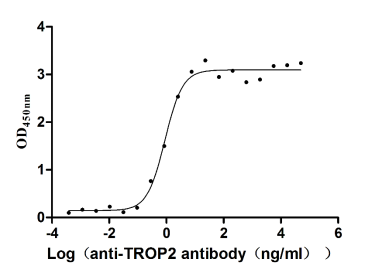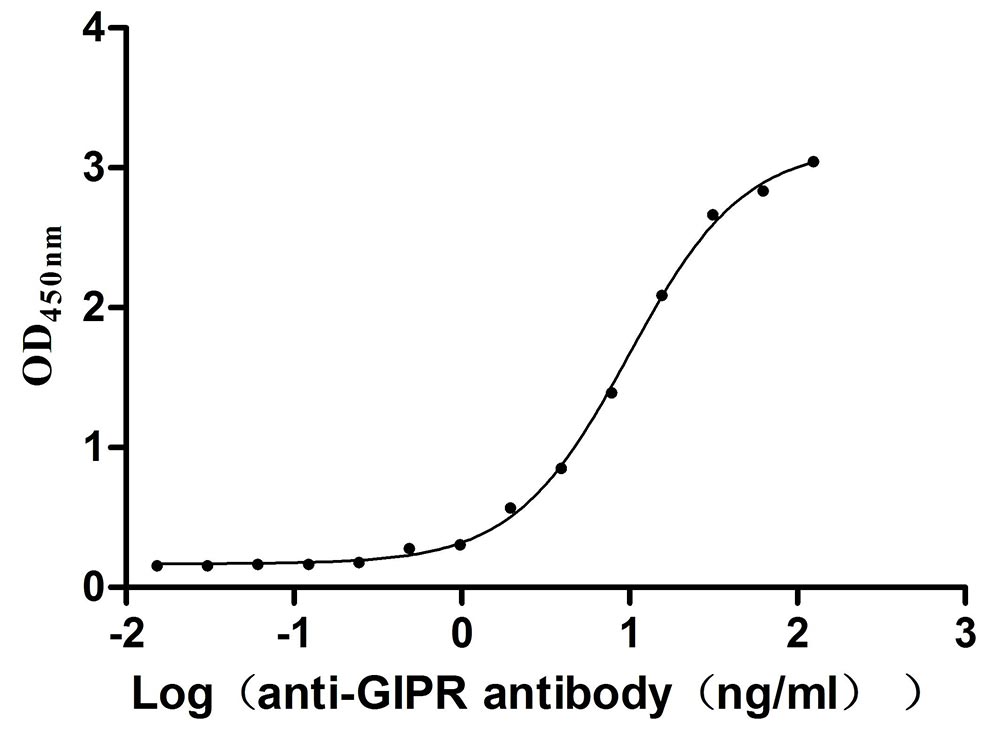Recombinant Mouse C-X-C motif chemokine 14 protein (Cxcl14)
In Stock-
中文名稱:Recombinant Mouse C-X-C motif chemokine 14 protein(Cxcl14) (Active)
-
貨號(hào):CSB-AP001181MO
-
規(guī)格:¥852
-
圖片:
-
其他:
產(chǎn)品詳情
-
純度:>95% as determined by SDS-PAGE.
-
內(nèi)毒素:Less than 1.0 EU/μg as determined by LAL method.
-
生物活性:Fully biologically active when compared to standard. The biological activity determined by a chemotaxis bioassay using human monocytes is in a concentration range of 1.0-10 ng/ml.
-
基因名:Cxcl14
-
Uniprot No.:
-
別名:Cxcl14; Bmac; Kec; Ks1; Mip2g; Scyb14C-X-C motif chemokine 14; B-cell and monocyte-activating chemokine; Chemokine BRAK; Kidney-expressed chemokine CXC; MIP-2G; Small-inducible cytokine B14
-
種屬:Mus musculus (Mouse)
-
蛋白長(zhǎng)度:Full Length of Mature Protein
-
來(lái)源:E.Coli
-
分子量:9.4 kDa
-
表達(dá)區(qū)域:23-99aa
-
氨基酸序列SKCKCSRKGP KIRYSDVKKL EMKPKYPHCE EKMVIVTTKS MSRYRGQEHC LHPKLQSTKR FIKWYNAWNE KRRVYEE
-
蛋白標(biāo)簽:Tag-Free
-
產(chǎn)品提供形式:Liquid or Lyophilized powder
Note: We will preferentially ship the format that we have in stock, however, if you have any special requirement for the format, please remark your requirement when placing the order, we will prepare according to your demand. -
緩沖液:0.2 μm filtered PBS, pH 7.4 ,lyophilized
-
儲(chǔ)存條件:Store at -20°C/-80°C upon receipt, aliquoting is necessary for mutiple use. Avoid repeated freeze-thaw cycles.
-
保質(zhì)期:The shelf life is related to many factors, storage state, buffer ingredients, storage temperature and the stability of the protein itself.
Generally, the shelf life of liquid form is 6 months at -20°C/-80°C. The shelf life of lyophilized form is 12 months at -20°C/-80°C. -
貨期:5-10 business days
-
Datasheet & COA:Please contact us to get it.
相關(guān)產(chǎn)品
靶點(diǎn)詳情
-
功能:Chemotactic for CESS B-cells and THP-1 monocytes, but not T-cells.
-
基因功能參考文獻(xiàn):
- Platelets are a relevant source of CXCL14. Platelet-derived CXCL14 at the site of vascular lesions might play an important role in vascular repair/regeneration. PMID: 28359053
- CXCL14 Tg mice showed a suppressed rate of carcinogenesis, decreased tumour volume, and reduced pulmonary metastasis, as well as an increased survival rate of mice following tumour cell injection. PMID: 25765541
- CXCL14 does not seem to play a pivotal role during influenza and Escherichia coli infections of the lung. PMID: 25313607
- CXCL14 was able to promote bone metastasis through enhancement of cancer cell tropism to the bone and/or recruitment of bone marrow cells around metastatic cancer cells. PMID: 24534874
- In conclusion, our results suggested the important function of Cxcl14 in uNK cells and the proper level of Cxcl14 protein were required to recruit NK cells to pregnant uterus. PMID: 23688424
- the transient expression of CXCL14 by Purkinje cells in the developing cerebellum, suggesting that it must be involved in the postnatal maturation of the cerebellum PMID: 22843118
- CXCL14 may play an important role in central nervous system regulation of feeding behavior PMID: 20428232
- Study identifies CXCL14 as a novel marker of tendon connective tissue. PMID: 21038449
- Murine CXCL14 is dispensable for the homeostatic recruitment of antigen-presenting cells toward the periphery and for LC functionality. PMID: 17130243
- CXCL14 is a critical chemoattractant of white adipose tissue macrophages and a novel regulator of glucose metabolism that functions mainly in skeletal muscle. PMID: 17724031
- These results suggest that CXCL14 plays a causal role in high-fat diet-induced obesity. PMID: 17971304
- Data suggest that despite the structural homology and similarity in tissue distribution of human and murine CXCL14, distinct differences point to diverse, species-specific needs for CXCL14 in epithelial immunity. PMID: 18809336
- findings demonstrate that early overexpression of PMP22 in a mouse model of Charcot-Marie-Tooth disease type 1A results in a strong up-regulation of CXCL14 which seems to play a novel regulatory role in Schwann cell differentiation PMID: 19111616
- CXCL14 is an important paracrine/autocrine modulator regulating trophoblast outgrowth at the maternal-fetal interface during the process of pregnancy establishment. PMID: 19626669
- These data indicate the possibility that BRAK expression inhibits tumor cell establishment by regulating interactions between tumor stem cells and NK cells and/or suppressing formation of tumor microvessels. PMID: 19887729
顯示更多
收起更多
-
亞細(xì)胞定位:Secreted.
-
蛋白家族:Intercrine alpha (chemokine CxC) family
-
組織特異性:Highly expressed in brain, lung, ovary, muscle and in kidney and liver parenchyma, and at lower levels in bone marrow.
-
數(shù)據(jù)庫(kù)鏈接:
Most popular with customers
-
Recombinant Human T-cell immunoreceptor with Ig and ITIM domains (TIGIT), partial (Active)
Express system: Mammalian cell
Species: Homo sapiens (Human)
-
Recombinant Human Glypican-3 (GPC3) (G537R), partial (Active)
Express system: Mammalian cell
Species: Homo sapiens (Human)
-
Recombinant Human Insulin growth factor-like family member 1 (IGFL1) (Active)
Express system: Mammalian cell
Species: Homo sapiens (Human)
-
Recombinant Mouse Microtubule-associated protein tau (Mapt) (Active)
Express system: Mammalian cell
Species: Mus musculus (Mouse)
-
Recombinant Mouse Retinol-binding protein 4 (Rbp4) (Active)
Express system: Mammalian cell
Species: Mus musculus (Mouse)
-
Recombinant Human Claudin-6 (CLDN6)-VLPs, Fluorescent (Active)
Express system: Mammalian cell
Species: Homo sapiens (Human)
-
Recombinant Human Tumor-associated calcium signal transducer 2 (TACSTD2), partial (Active)
Express system: Mammalian cell
Species: Homo sapiens (Human)
-
Recombinant Mouse Gastric inhibitory polypeptide receptor (Gipr), partial (Active)
Express system: Mammalian cell
Species: Mus musculus (Mouse)




-AC1.jpg)



f4-AC1.jpg)












